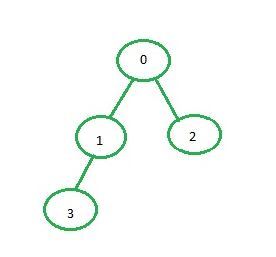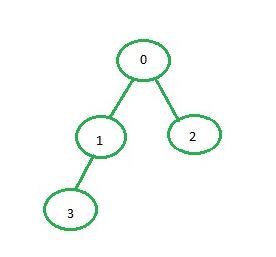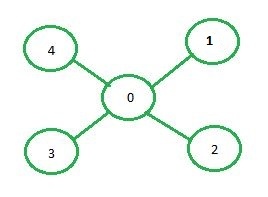本文讨论了广度优先搜索(BFS),它使用邻接表表示图形。在本文中,邻接矩阵将用于表示图。
邻接矩阵表示:在图的邻接矩阵表示中,大小为n * n(其中n是顶点数量)的矩阵mat [] []将表示图的边缘,其中mat [i] [j] = 1表示在顶点i和j之间存在边,而mat [i] [j] = 0表示在顶点i和j之间没有边。

以下是上图中显示的图的邻接矩阵表示:
0 1 2 3
0 0 1 1 0
1 1 0 0 1
2 1 0 0 0
3 0 1 0 0例子:
Input: source = 0
Output: 0 1 2 3
Input: source = 1
Output:1 0 2 3 4方法:
- 创建一个大小为n * n的矩阵,其中每个元素均为0,表示图中没有边。
- 现在,对于顶点i和j之间的图的每个边,设置mat [i] [j] = 1。
- 创建并填充邻接矩阵后,按照本文所述,找到图的BFS遍历。
下面是上述方法的实现:
C++
// C++ implementation of the approach
#include
using namespace std;
class Graph {
// Number of vertex
int v;
// Number of edges
int e;
// Adjacency matrix
int** adj;
public:
// To create the initial adjacency matrix
Graph(int v, int e);
// Function to insert a new edge
void addEdge(int start, int e);
// Function to display the BFS traversal
void BFS(int start);
};
// Function to fill the empty adjacency matrix
Graph::Graph(int v, int e)
{
this->v = v;
this->e = e;
adj = new int*[v];
for (int row = 0; row < v; row++) {
adj[row] = new int[v];
for (int column = 0; column < v; column++) {
adj[row][column] = 0;
}
}
}
// Function to add an edge to the graph
void Graph::addEdge(int start, int e)
{
// Considering a bidirectional edge
adj[start][e] = 1;
adj[e][start] = 1;
}
// Function to perform BFS on the graph
void Graph::BFS(int start)
{
// Visited vector to so that
// a vertex is not visited more than once
// Initializing the vector to false as no
// vertex is visited at the beginning
vector visited(v, false);
vector q;
q.push_back(start);
// Set source as visited
visited[start] = true;
int vis;
while (!q.empty()) {
vis = q[0];
// Print the current node
cout << vis << " ";
q.erase(q.begin());
// For every adjacent vertex to the current vertex
for (int i = 0; i < v; i++) {
if (adj[vis][i] == 1 && (!visited[i])) {
// Push the adjacent node to the queue
q.push_back(i);
// Set
visited[i] = true;
}
}
}
}
// Driver code
int main()
{
int v = 5, e = 4;
// Create the graph
Graph G(v, e);
G.addEdge(0, 1);
G.addEdge(0, 2);
G.addEdge(1, 3);
G.BFS(0);
} Java
// Java implementation of the approach
import java.util.ArrayList;
import java.util.Arrays;
import java.util.List;
class GFG{
static class Graph
{
// Number of vertex
int v;
// Number of edges
int e;
// Adjacency matrix
int[][] adj;
// Function to fill the empty
// adjacency matrix
Graph(int v, int e)
{
this.v = v;
this.e = e;
adj = new int[v][v];
for(int row = 0; row < v; row++)
Arrays.fill(adj[row], 0);
}
// Function to add an edge to the graph
void addEdge(int start, int e)
{
// Considering a bidirectional edge
adj[start][e] = 1;
adj[e][start] = 1;
}
// Function to perform BFS on the graph
void BFS(int start)
{
// Visited vector to so that
// a vertex is not visited more than once
// Initializing the vector to false as no
// vertex is visited at the beginning
boolean[] visited = new boolean[v];
Arrays.fill(visited, false);
List q = new ArrayList<>();
q.add(start);
// Set source as visited
visited[start] = true;
int vis;
while (!q.isEmpty())
{
vis = q.get(0);
// Print the current node
System.out.print(vis + " ");
q.remove(q.get(0));
// For every adjacent vertex to
// the current vertex
for(int i = 0; i < v; i++)
{
if (adj[vis][i] == 1 && (!visited[i]))
{
// Push the adjacent node to
// the queue
q.add(i);
// Set
visited[i] = true;
}
}
}
}
}
// Driver code
public static void main(String[] args)
{
int v = 5, e = 4;
// Create the graph
Graph G = new Graph(v, e);
G.addEdge(0, 1);
G.addEdge(0, 2);
G.addEdge(1, 3);
G.BFS(0);
}
}
// This code is contributed by sanjeev2552 Python3
# Python3 implementation of the approach
class Graph:
adj = []
# Function to fill empty adjacency matrix
def __init__(self, v, e):
self.v = v
self.e = e
Graph.adj = [[0 for i in range(v)]
for j in range(v)]
# Function to add an edge to the graph
def addEdge(self, start, e):
# Considering a bidirectional edge
Graph.adj[start][e] = 1
Graph.adj[e][start] = 1
# Function to perform DFS on the graph
def BFS(self, start):
# Visited vector to so that a
# vertex is not visited more than
# once Initializing the vector to
# false as no vertex is visited at
# the beginning
visited = [False] * self.v
q = [start]
# Set source as visited
visited[start] = True
while q:
vis = q[0]
# Print current node
print(vis, end = ' ')
q.pop(0)
# For every adjacent vertex to
# the current vertex
for i in range(self.v):
if (Graph.adj[vis][i] == 1 and
(not visited[i])):
# Push the adjacent node
# in the queue
q.append(i)
# set
visited[i] = True
# Driver code
v, e = 5, 4
# Create the graph
G = Graph(v, e)
G.addEdge(0, 1)
G.addEdge(0, 2)
G.addEdge(1, 3)
# Perform BFS
G.BFS(0)
# This code is contributed by ng24_7输出:
0 1 2 3